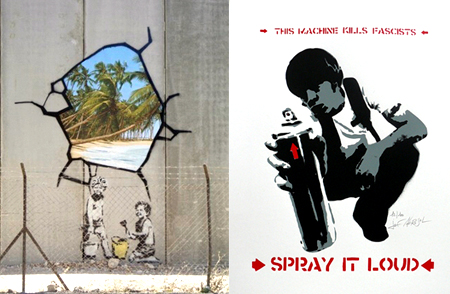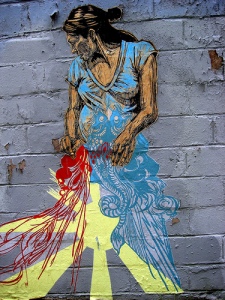Graffiti Definitions
This quick guide is to help you understand the terminology used bt street artists and what we commonly refer to in our blogs. It is not a difinative dictionary of all Graffiti definitions but it explains the most commonly used
A “Tag” is the most basic writing of an artist’s name in either spray paint or marker. A graffiti writer’s tag is his or her personalised signature. “Tagging” is often the example given when opponents of graffiti refer to vandalism, as they use it to label all acts of graffiti writing (it is by far the most common form of graffiti). Tags can contain subtle and sometimes cryptic messages, and might incorporate the artist’s initials or other letters. As well as the graffiti name, some artists include the year that they completed that tag next to the name
Graf: shortened meaning of Graffiti
Stencil or Cut Out Graffiti: are made by drawing an image onto a piece of cardboard or tougher versions of paper, then cut with a razor blade. What is left is then just simply sprayed-over, and if done correctly, a perfect image is left.
Throw-up or Fill-in: normally painted very quickly with two or three colours, sacrificing aesthetics for speed. Throw-ups can also be outlined on a surface with one colour
A piece: is a more elaborate representation of the artist’s name, incorporating more stylized “block” or “bubble” letters, using three or more colours. This of course is done at the expense of timeliness and increases the likelihood of the artist getting caught.
Blockbuster: is a large piece done with a roller that consists of two contrasting colours
Wildstyle: a form of graffiti involving interlocking letters, arrows, and connecting points. These pieces are often harder to read by non-graffiti artists as the letters merge into one another in an often undecipherable manner
Roller: is a “fill-in” that intentionally takes up an entire wall, sometimes with the whole purpose of blocking other “taggers” from painting on the same wall. Some artists also use stickers as a quick way to “get-up”
Sticker tags: are commonly done on blank postage stickers, or really anything with an adhesive side to it. While its critics consider this as lazy and a form of cheating, others find that 5 to 10 minutes spent on a detailed sticker is in no way lazy, especially when used with other methods
Capping: It involves one writer spraying/ tagging over another writers work. This is most commonly done when there is “beef” or a conflict between writers
Bomb or Hit: is to paint many surfaces in an area. Bombers often choose throw-ups or tags over complex pieces, as they can be executed more quickly
Paste ups or Street poster art: graphic images and words on newspaper-thin paper often exploring political viewpoints. It explores attributes (like languages and/or techniques) of the traditional poster. The thin nature of the poster and the adhesive used to attach them is designed to make the posters hard to tear or remove
Further meanings can also be found via:
As we have not been able to find a true Graffiti Glossary here in Australia we are interested in expanding our Graffiti Definitions to truly reflect Australian meanings. If you have any further definitions you would like to share with us please leave us a comment



[…] What’s Your Favourite Form of Graffiti? For definitions of styles see: Graffiti Definitions – Beginner’s Guide […]
By: What’s Your Favourite Form of Graffiti? « Core TV 1 - Melbourne on December 10, 2008
at 1:06 pm
[…] that they completed that tag next to the name – Graf: shortened meaning of Graffiti (Says https://coretv1.wordpress.com/2008/11/25/graffiti-definitions-beginners-guide/ […]
By: | robertdstorm's Blog on May 18, 2010
at 5:49 pm
[…] die van te voren worden uitgesneden. Enkele andere populaire technieken zijn sticker bombing, papier aanplakken en er bestaat zelfs […]
By: Street art: doe het zelf on November 23, 2012
at 9:50 pm